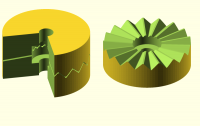Hi,
Guest

Hirth joint revisited.
RW
Raymond West
Tue, Jan 7, 2025 9:18 PM
Attached is the scad code, and comments explaining a simple
machining process.
If you run the script, and read through the comments, you will see
that they broadly refer to the six evolving images, from left to right
(f5 will show the tool path). The actual necessary script to create a
working example is quite short, and a consists of a few, fairly simple
modules - flatten, flatpath, single, blank, path, cutter_profile, and
also ten parameters and three equations for 'chord', 'dg' and 'art'.
Equally the machining instructions, either for manual or automatic, are
also quite straightforward. The difficulty, as always would be in the
fixtures for the workpiece, unless it is a simple blank, as in this example.
Attached is the scad code, and comments explaining a simple
machining process.
If you run the script, and read through the comments, you will see
that they broadly refer to the six evolving images, from left to right
(f5 will show the tool path). The actual necessary script to create a
working example is quite short, and a consists of a few, fairly simple
modules - flatten, flatpath, single, blank, path, cutter_profile, and
also ten parameters and three equations for 'chord', 'dg' and 'art'.
Equally the machining instructions, either for manual or automatic, are
also quite straightforward. The difficulty, as always would be in the
fixtures for the workpiece, unless it is a simple blank, as in this example.
Replying to:
Empathy v1.0
2025 ©emwd.com

